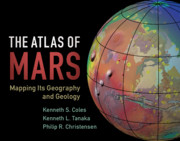Book contents
- The Atlas of Mars
- Additional material
- The Atlas of Mars
- Copyright page
- Table of Contents
- Preface
- Acknowledgments
- Abbreviations
- How to Use this Atlas
- Sources of Images
- Chapter 1 Introduction
- Chapter 2 History of Exploration of Mars
- Chapter 3 Global Character of Mars
- Chapter 4 Regional Geographic Features and Surface Views of Mars
- Chapter 5 Geology of Mars
- Map Sheets
- Mare Boreum (MC-1)
- Diacria (MC-2)
- Arcadia (MC-3)
- Mare Acidalium (MC-4)
- Ismenius Lacus (MC-5)
- Casius (MC-6)
- Cebrenia (MC-7)
- Amazonis (MC-8)
- Tharsis (MC-9)
- Lunae Palus (MC-10)
- Oxia Palus (MC-11)
- Arabia (MC-12)
- Syrtis Major (MC-13)
- Amenthes (MC-14)
- Elysium (MC-15)
- Memnonia (MC-16)
- Phoenicis Lacus (MC-17)
- Coprates (MC-18)
- Margaritifer Sinus (MC-19)
- Sinus Sabaeus (MC-20)
- Iapygia (MC-21)
- Mare Tyrrhenum (MC-22)
- Aeolis (MC-23)
- Phaethontis (MC-24)
- Thaumasia (MC-25)
- Argyre (MC-26)
- Noachis (MC-27)
- Hellas (MC-28)
- Eridania (MC-29)
- Mare Australe (MC-30)
- Moons: Phobos and Deimos
- Appendix
- Gazetteer
- References
- Index
Coprates (MC-18)
from Map Sheets
Published online by Cambridge University Press: 16 August 2019
- The Atlas of Mars
- Additional material
- The Atlas of Mars
- Copyright page
- Table of Contents
- Preface
- Acknowledgments
- Abbreviations
- How to Use this Atlas
- Sources of Images
- Chapter 1 Introduction
- Chapter 2 History of Exploration of Mars
- Chapter 3 Global Character of Mars
- Chapter 4 Regional Geographic Features and Surface Views of Mars
- Chapter 5 Geology of Mars
- Map Sheets
- Mare Boreum (MC-1)
- Diacria (MC-2)
- Arcadia (MC-3)
- Mare Acidalium (MC-4)
- Ismenius Lacus (MC-5)
- Casius (MC-6)
- Cebrenia (MC-7)
- Amazonis (MC-8)
- Tharsis (MC-9)
- Lunae Palus (MC-10)
- Oxia Palus (MC-11)
- Arabia (MC-12)
- Syrtis Major (MC-13)
- Amenthes (MC-14)
- Elysium (MC-15)
- Memnonia (MC-16)
- Phoenicis Lacus (MC-17)
- Coprates (MC-18)
- Margaritifer Sinus (MC-19)
- Sinus Sabaeus (MC-20)
- Iapygia (MC-21)
- Mare Tyrrhenum (MC-22)
- Aeolis (MC-23)
- Phaethontis (MC-24)
- Thaumasia (MC-25)
- Argyre (MC-26)
- Noachis (MC-27)
- Hellas (MC-28)
- Eridania (MC-29)
- Mare Australe (MC-30)
- Moons: Phobos and Deimos
- Appendix
- Gazetteer
- References
- Index
Summary
In this quadrangle, the deepest canyon system on Mars and one of the most spectacular in the solar system, Valles Marineris, extends more than 2,500 km across the map, cutting the northern part of the Thaumasia plateau (informal name). Parts of the floor are more than 5,000 m below datum and as much as 10,000 m below the plateau rim. The system of canyons includes Melas, Candor, and Ophir Chasmata, prominent at its central part, Coprates along its eastern part, and Ius and Tithonium Chasmata, forming its western arm. Echus, Hebes, Juventae, and Ganges Chasmata form additional, separate canyons, north of the main canyon system. The canyons of Noctis Labyrinthus, west of the map (MC-17), join Valles Marineris, which connects eastward with the chaos-filled canyons of Capri and Eos Chasmata. Some of the other chasmata are linked to outflow channels north (MC-10) and east of the map (MC-19). Sinai, Solis, and Thaumasia Plana make up high plains that span the western to south–central parts of the Coprates quadrangle. Together they constitute much of the Thaumasia plateau, a dish-shaped, elevated region at 3,000–5,000 m. At their eastern edges, the Thaumasia plateau and Ophir Planum drop as much as 3,000 m down to variably cratered plains of Noachis and Xanthe Terrae, respectively. The informally named Coprates rise is a prominent north-trending mountain range, forming the eastern margin of the Thaumasia plateau, south of Coprates Chasma. Crossing this entire region are north- to northeast-trending wrinkle ridges as well as local sets of narrow grabens and pit chains.
- Type
- Chapter
- Information
- The Atlas of MarsMapping its Geography and Geology, pp. 162 - 169Publisher: Cambridge University PressPrint publication year: 2019



